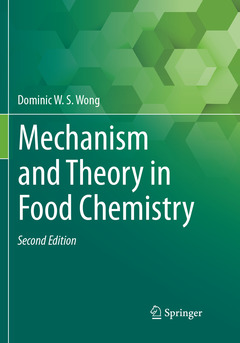Description
Mechanism and Theory in Food Chemistry, Second Edition (2nd Ed., Softcover reprint of the original 2nd ed. 2018)
Author: Wong Dominic W.S.
Language: English
Subjects for Mechanism and Theory in Food Chemistry, Second Edition:
Approximative price 60.12 €
In Print (Delivery period: 15 days).
Add to cartPublication date: 08-2018
Support: Print on demand
Approximative price 84.39 €
In Print (Delivery period: 15 days).
Add to cartPublication date: 11-2017
Support: Print on demand
Description
/li>Contents
/li>Biography
/li>Comment
/li>
For the first time in over twenty-five years, this unique and popular textbook on food chemistry mechanism and theory has received a full update. Emphasizing the underlying chemical reactions and interactions that occur in foods during processing and storage, this book unifies the themes of "what", "how" and "why" in the language of equations, reactions and mechanisms.
This book is the only work which provides in-depth focus on aspects of reaction mechanisms and theories in the chemistry of food and food systems. With more than 500 chemical equations and figures, this book provides unusual clarity and relevance, and fills a significant gap in food chemistry literature. It is a definitive source to consult regarding the important mechanisms that make food components and reactions tick.
Mechanism and Theory in Food Chemistry has been a popular resource for students and researchers alike since its publication in 1989. This important new edition contains updates on the original text encompassing a quarter century of advances in food chemistry. Many parts of the original chapters are revised to make for smoother navigation through the subjects, to better explain the underlying chemistry concepts and to fulfill the need of adding topics of emerging importance. New sections on fatty acids, lipid oxidation, meat, milk, soybean and wheat proteins, starch and many more have been incorporated throughout the revision. This updated edition provides an excellent source of all the important chemical mechanisms and theories involved with food science.
LIPID
Fatty Acids and Triacylglycerols
Lipid Oxidation
Thermal and Oxidative Thermal Reactions
Radiolysis of Lipids
Hydrogenation
InteresterificationPolymorphism of Triglycerides
Plasticity of Fat
Emulsions
Emulsifiers
Liquid-Crystalline Mesophase in Emulsifier-Water System
Functions of Emulsifiers in Stabilization
Antioxidants
2. PROTEINS
Protein Structure
Protein-Stabilized Emulsification and Foaming
Gel Formation
Chemical Reaction
Meat ProteinsMilk Proteins
Wheat Proteins
Wheat Proteins
Collagen
3. CARBOHYDRATES
Glycosidic LinkageAction of Alkali on Monosaccharides
Action of Acid on Monosaccharides
Nonenzymatic Browning (Maillard Reaction)
Complexes of Sugars with Metal Ions
Starch
Alginate
Pectin
Carrageenan
Cellulose
Xanthan Gum
b-Glucan
4. COLORANTS
Light AbsorptionConjugation
Substituent Effects
Carotenoids
Annatto
Anthocyanins
Betanain
Caramel
Dyes and Lakes
Coordination Chemistry
Metalloporphyrin-Electronic Structure
Myoglobin
Chlorophyll
5. ENZYMES
Papain
Lipoxygenase
Polyphenol Oxidase
Glucose Oxidase
Amylases
Pectic EnzymesLipolytic Enzymes
Xylose Isomerase
6. FLAVORS
The Sensation of Taste
The Mechanism of Taste Sensation
Test EnhancersOdor- The Site Fitting Theory
Character-Impact Compounds
Odorant Receptors
Origin of Flavor
Beverage Flavor
Spice Flavor
Fruits and VegetablesMeat Flavor
Microencapsulation of Flavors
7. SWEETENERS
Molecular Theory of Sweeteners
Sweet Taste Receptors
Amino Acids and DipeptidesThe Aminosulfonates
Dihydrochalcone
Glycyrrhizin
Stevioside
Sugar Alcohol
Corn SweetenersSweet Proteins
Flavor Potentiators
8. NATURAL PRODUCTS
Cyanogenic Glycosides
Glycoalkaloids
Glucosinolates
MethylxanthinesAmino Acids, Peptides, and Proteins
Amines
Mycotoxins
Polyclinic Aromatic Hydrocarbons
Heterocyclic Amines
Nitrosamines
9. ADDITIVES
Phosphates
Citric Acid
Phosphoric acid
Antimicrobial Short-Chain DerivatesSulfites
10. VITAMINS
Vitamin A
Vitamin B1
Vitamin B2
Vitamin B6Vitamin B12
Biotin
Niacin
Vitamin C
Vitamin D
Vitamin E
APPENDIX
1. General Kinetics of Olefin Autoxidation
2. Singlet Oxygen
3. Where do the Radicals Come From?
4. The FlavonoidsDominic Wong is a Research Chemist at Western Regional Research Center, USDA-ARS, in Albany, CA
Provides students with comprehensively updated version of the popular text, Mechanism and Theory in Food Chemistry
Includes many brand new sections incorporating new methods, technologies and theories not covered in the first edition. These include fatty acids, lipid oxidation, meat, milk and wheat proteins, starch and many more
Offers the most comprehensive overview of the mechanisms and theories behind the practical application of food science available on the market today




